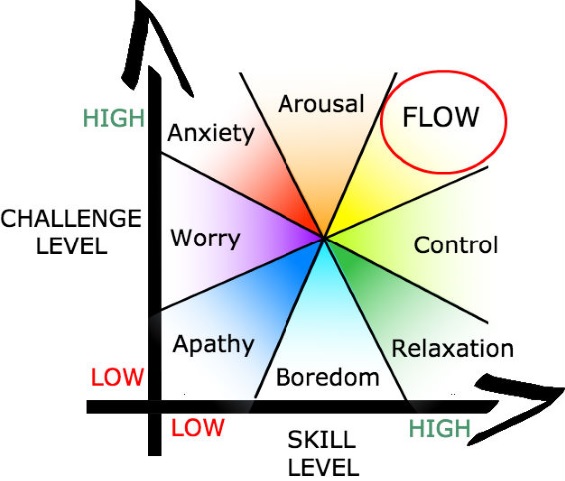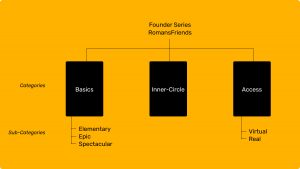There is an interesting way to look at the issue of employee motivation. It can also be summarized as "Voluntary challenge vs. forced work: the puzzle of human motivation".
Logically, the question arises: Under what conditions does a person prefer to take on a challenge? Under what conditions is work fun? What conditions ensure that people feel like performing?
Flow: Employee motivation and performance in harmony
The term 'flow' describes the state in which people are completely immersed in an activity and experience a sense of pleasure, immersion and control. This state can lead to increased motivation and performance.
Flow is a state when we feel our best and experience our most productive moments. It is a feeling of total immersion in a task, where we are fully focused on what we are doing and forget about all other distractions and worries. In this state, we feel energized and our actions seem effortless. Time seems to pass without us noticing, and we experience a sense of joy and fulfillment.
The idea of flow was explored by renowned psychologist Mihaly Csikszentmihalyi and published in his groundbreaking book ‚Flow: The Psychology of Optimal Experience‘ . Csikszentmihalyi described flow as the state of happiness and satisfaction achieved through complete immersion and focus on a challenging activity.

To reach the state of flow, certain conditions must be met. One of it is that the activity is sufficiently demanding. There should be a balance between a person's abilities and the challenges of the task. If the activity is too easy, it can lead to boredom, while a task that is too difficult can cause frustration and anxiety.
Flow and employee motivation
The state of flow can have significant benefits. People are more motivated, productive and creative when they are in flow. They experience an improved sense of well-being, as the flow state is associated with happiness and satisfaction. In addition, people in flow are better able to focus on the task at hand and ignore distracting thoughts.
There are various activities that can trigger the state of flow. There are also people who are more inclined to seek challenges and experience flow in their work. These individuals are motivated to engage in challenging and meaningful tasks. However, the fact that this is not a question of 'genes' or the like, but rather has more to do with personal attitude and how you can develop and promote this, we have discussed in the article THE TOOL FOR GROWTH MINDSET .
Individuals who tend to seek out challenges and may even actively seek out flow experiences in their work can not only increase their own satisfaction, but also contribute to better work outcomes and higher work motivation.
The working conditions for employee motivation
In order to promote flow experiences in the workplace, various conditions can be created. One important condition is that the tasks are challenging and meaningful. Boring and repetitive tasks do not lead to flow experiences because they do not provide an opportunity to immerse oneself in a state of concentration and full engagement.
This very requirement shows how often companies still unconsciously design jobs according to specifications, contrary to the possible flow experience. Because with the goal of efficiency and with the goal of simplifying the work process, managers often design jobs in the direction of predictability and repetition. (see also Why Managers Design Jobs to Be More Boring Than They Need to Be)
At this point, it becomes clear why the issue of employee motivation is far more than an individual challenge - it is a systemic concern that lies in the hands of the organization. It's a paradox: Many companies rely on structures that emphasize efficiency, predictability, and strict guidelines, only to invest enormous resources in increasing employee motivation. Yet research clearly shows that employees are motivated primarily by autonomy, meaningful challenges and the opportunity for personal development. It is time for organizations to recognize this contradiction and create framework conditions that truly suit human nature.
Furthermore, an environment should be created that allows employees to concentrate on their tasks. Distracting factors such as noise, interruptions and unnecessary meetings should be minimized. A quiet and organized workplace can help promote flow experiences.
It is also helpful to give employees the opportunity to shape their own work. This means that they can make decisions and influence their tasks and work processes. Self-determination and autonomy are important factors that can contribute to flow experiences.
The importance of recognition
In a working environment where employees can successfully use their competencies and skills, they feel valued and motivated. Recognition for good performance is an important factor in increasing employee motivation and satisfaction. Studies have shown that employees who feel recognized are more productive, have higher job satisfaction and are less likely to take sick leave.
But please do not confuse a previously announced and self-earned reward (be it a bonus, a benefit in kind or similar) with recognition. Even if the reward given is intended as recognition from the company's point of view, there is a great risk that it will not be received as such by the employee and will therefore hardly contribute to employee motivation.
If an employee earns a bonus for his or her performance that has been deliberately announced in advance, then this bonus is considered, from a psychological point of view, to be an obligatory contribution by the employer. It is like a deal and a contract that one enters into: The company has committed itself to the fact that the employee is entitled to a bonus in the event of corresponding performance. The actual payment of the bonus is then a commitment to the employee.
But let's imagine that there was no announcement and the employer comes rather surprisingly, because unannounced, to the employee and hands over a bonus, then he does this, felt, without the obligation to have to pay out this bonus. And yet he does it. Now I ask you, what is more likely to be perceived as recognition on the part of the employee and thus make its contribution to employee motivation?
It is therefore crucial that companies and supervisors understand the importance and psychology behind employee recognition and take active steps to do so.
The importance of bonding
Bonding is an essential part of human coexistence and also has great significance in the work context. It is a reward for joint action and reinforces the performance of a team or group. An apt example of this is lions hunting together, clearly demonstrating the importance of affiliation, communication, positioning, virtues and goals. Employees also need recognition and retention to stay motivated and develop their full potential.
The bond within a team is comparable to the strong bonds that lions have in the wild. They hunt prey together and share the rewards. This not only strengthens the sense of togetherness, but also enables them to hunt down larger prey together, from which they all benefit. Similarly, in a work environment, when employees work together in a team and support each other, they can overcome greater challenges together and achieve better results.
Positioning within the team or group is another important factor for retention. Each employee has his or her own strengths and skills to contribute. Optimal positioning of employees enables them to realize their potential and perform their tasks effectively. This highlights the potential of roles, in the context of employee motivation. Often, roles in companies are equated with titles.
Still far too little, albeit slowly growing, is given to the importance of roles defined by acquired skills. It is important to make these recognizable and tangible for the employees and that they can be 'conquered' over time. This ensures appreciation of the time and effort invested, especially by the people involved themselves (see also IKEA-Effect)

8 clear steps for optimal framework conditions & employee motivation
1. clear goals and expectations
Employees should know exactly what is expected of them and what goals they are expected to achieve. This creates clear direction and allows employees to focus on the task at hand. Key performance indicators are NOT goals in this sense. Clear goals and expectations from a human perspective are more effectively communicated through narratives that relate more to the 'why' of the (in this case) business activity. Metrics are only a means to an end on the way to the 'why'.
2. immediate feedback
Quick and concrete feedback allows employees to see their progress and make adjustments if necessary. This keeps motivation high and promotes flow. In such an environment, even regressions can be experienced as learning opportunities and thus also as indirect progress due to the direct possibility of action thanks to rapid feedback. A powerful instrument for increasing corporate resilience.
3. suitable challenges
The tasks should be neither too easy nor too difficult. They should offer just the right amount of challenge to match the employee's competence. Tasks that are too easy lead to boredom, and those that are too difficult lead to frustration. But this also means that since people as such learn to adapt, especially in a stable environment, and thus continue to develop, the job requirements must grow with them. This is the only way to avoid the danger of experienced monotony and boredom.
4. autonomy and control
Employees should have the freedom to make decisions and shape their own work. This promotes a sense of control and enables them to immerse themselves in the flow state. Particularly in retrospect, the autonomy experienced also enables a sense of pride and fulfillment, as a positive state has been achieved by making one's own decisions.
5. time for concentration
Interruptions and distractions should be minimized. This includes meetings and constant notifications. Employees should be able to concentrate on their tasks without interruption.
6. significance and meaningfulness
The work should be meaningful and significant for the employee. This increases intrinsic motivation and makes it more likely that the flow state will be achieved. Again, we would be reinforcing the narrative. Sales, shareholder satisfaction, achieving business goals, being #1 in the market, etc. have rational meaning but have little emotional impact.
7. social support
A supportive team and a positive work atmosphere can also contribute to achieving the flow state. Collegial support and a good relationship with superiors can increase motivation. Especially one's own role in supporting colleagues.
8. room for creativity and innovation
Employees should have the opportunity to contribute new ideas and find creative solutions. This promotes curiosity and the willingness to immerse oneself in the work.
The conclusion on employee motivation
Creating flow experiences and giving recognition to employees are crucial factors for employee motivation and performance in the workplace. More and more companies are recognizing the importance of these aspects and are implementing targeted measures to promote flow and provide recognition.
Flow refers to the state in which a person is completely immersed in an activity, experiencing a sense of deepened concentration and satisfaction. These flow experiences are not only important for the individual well-being of employees, but also have positive effects on productivity and performance.
To enable flow in the workplace, companies should create suitable conditions. We have given you 8 crucial points here.
🌟 Einladung zum Webinar: GROWTH MINDSET: GAMIFICATION ALS KATALYSATOR

Liebe Community,
wir freuen uns, Sie zu unseren exklusiven Webinaren einzuladen. Für Ihren Gamification-Flow im November können wir Ihnen bereits drei hilfreiche Webinare anbieten.
Sie finden eine Übersicht über die aktuell geplanten Webinare hier im Link:


